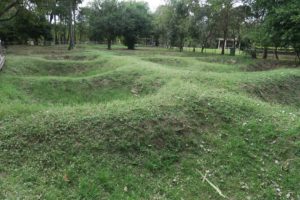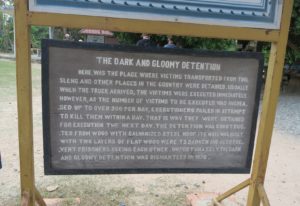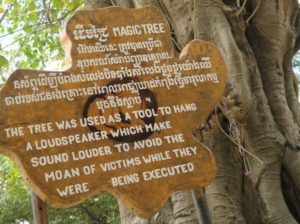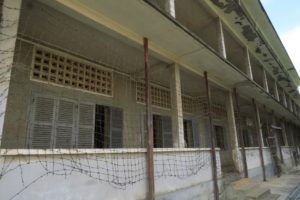The Killing Fields of Cambodia

 Between 1975 and 1979, the Khmer Rouge under the power of Pol Pot, took control of Cambodia and systematically executed over a million people over the course of four years. Another million died of starvation, disease and torture. The term killing fields comes from the mass graves found throughout Cambodia.
Between 1975 and 1979, the Khmer Rouge under the power of Pol Pot, took control of Cambodia and systematically executed over a million people over the course of four years. Another million died of starvation, disease and torture. The term killing fields comes from the mass graves found throughout Cambodia.
Before you read any furthers, I want to note that is a going to be emotional, graphic and horrifying read about what I learned when I visited the Choeung Ek Genocidal Center and Toul Sleng Genocide Museum in Phnom Penh, Cambodia. I went with two other travels I met at my hostel. We started with the Choeung Ek Genocidal Center, then the Toul Sleng Genocide Museum. The history and personal accounts of the Cambodian genocide are very well presented through audio guides offered in both locations. While, Angkor Wat is a very well know place to visit in Cambodia, I cannot stress how important it is to learn about the Killing Fields of Cambodia and it how it continues to impact the country today. The Cambodian Genocide is a modern-day horror story that happened within the lifetime of anyone over the age of 38 today. I can only wish that people were not only taught about tragedies but also how to recognize the characteristics of events that lead to these tragedies happening in the first place so that maybe one day history can stop repeating itself.
My brief summary is just that, the tip of the iceberg. I encourage your to do further research into the Cambodian genocide so that we can continue to educate ourselves.
.
Choeung Ek Genocidal Center
 The Choeungek Genocidal Center in Phnom Penh is one of the largest of the +300 killing fields in Cambodia. After the Khmer Rouge came into power, the people rejoiced at the promises of prosperity and change. However, the people quickly realized this was not the case. The Khmer Rouge wanted to eliminate hierarchy, possession and make all men equal again by adopting a communist way of living. To achieve this goal, the Khmer Rouge executed previous government leaders, professionals, bilinguals, anyone with glasses, soft hands and intellectuals of any sort. First these people were tortured for false confessions of colluding against the regime. Once the Khmer Rouge had the confessions, the prisoners were blindfolded, packed into vans in the middle of the night and taken into the countryside. The prisoners were told that they were being moved to another location to meet their families or put to work. A lie to keep them calm. Once at the destinations, they were executed and thrown into larges ditches dug into the ground. The Killing Fields.
The Choeungek Genocidal Center in Phnom Penh is one of the largest of the +300 killing fields in Cambodia. After the Khmer Rouge came into power, the people rejoiced at the promises of prosperity and change. However, the people quickly realized this was not the case. The Khmer Rouge wanted to eliminate hierarchy, possession and make all men equal again by adopting a communist way of living. To achieve this goal, the Khmer Rouge executed previous government leaders, professionals, bilinguals, anyone with glasses, soft hands and intellectuals of any sort. First these people were tortured for false confessions of colluding against the regime. Once the Khmer Rouge had the confessions, the prisoners were blindfolded, packed into vans in the middle of the night and taken into the countryside. The prisoners were told that they were being moved to another location to meet their families or put to work. A lie to keep them calm. Once at the destinations, they were executed and thrown into larges ditches dug into the ground. The Killing Fields.

The audio guides and illustrations describe horrifying scenes where these blindfolded prisoners are lined up and brought to a mass grave. To hide the sound of death, the Khmer Cadres played music through loud speakers and the sound of a loud engines that powered them muffled the screams. The prisoners were brutally executed with a blow to the head by a hammer, a shovel, a rod or any other blunt object and then a slash across the throat.
Guns were not used as bullets were expensive and the sound too loud to be muffled. Once a ditch was filled, it was immediately covered with dirt and the cycle of horror started again. Even though many of the remains have been unearthed in Phnom Penh and place in a memorial, teeth, bones and cloth resurface to this day after heavy rains.
Toul Sleng Genocide Museum
Toul Sleng Genocide Museum also called S-21, was once a high school that was taken over by the Khmer Rouge and turned into a secret center for torture and imprisonment. This place consists of 4 building that chill you to the bones when you enter. My mouth was dry and alkaline and many of the other visitors and I had to stop and take a break outside from the nausea of being in such a place. This was a place for the dehumanization of it’s prisoners. The Cadres were taught how to torture without killing and how to keep the prisoners alive so they can be killed only at the killing fields. There are censored photographs of tortured prisoners, torture machines left behind by the regime, clothing and foot shackles. The Khmer Rouge kept details reports on all the prisoners. The photographs of many of the prisoners can be viewed in some of the buildings. The audio guide recounts the cruelty of the torture and has personal stories from the few survivors. Two of the buildings were turned into individual holdings cells. The cells are still there today.

